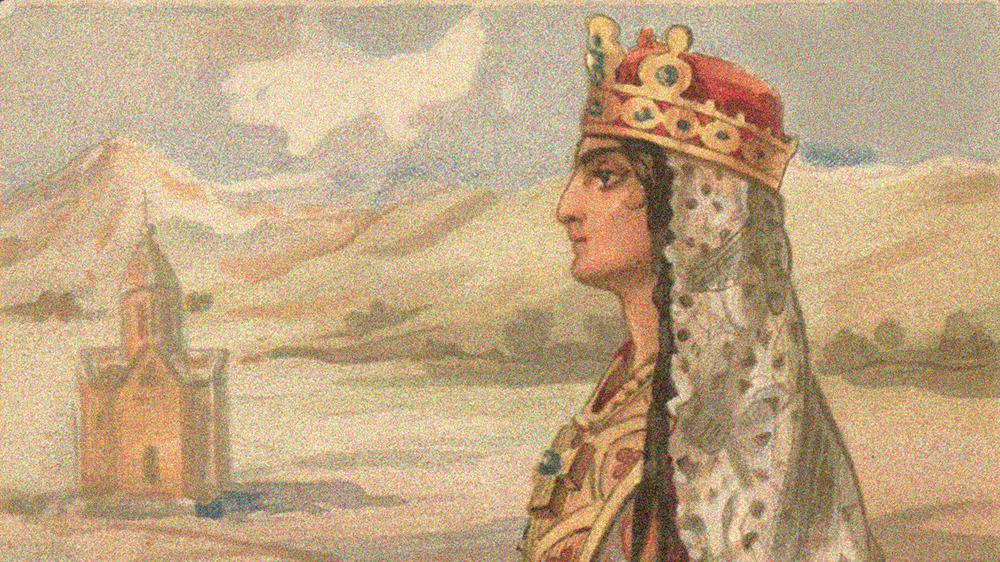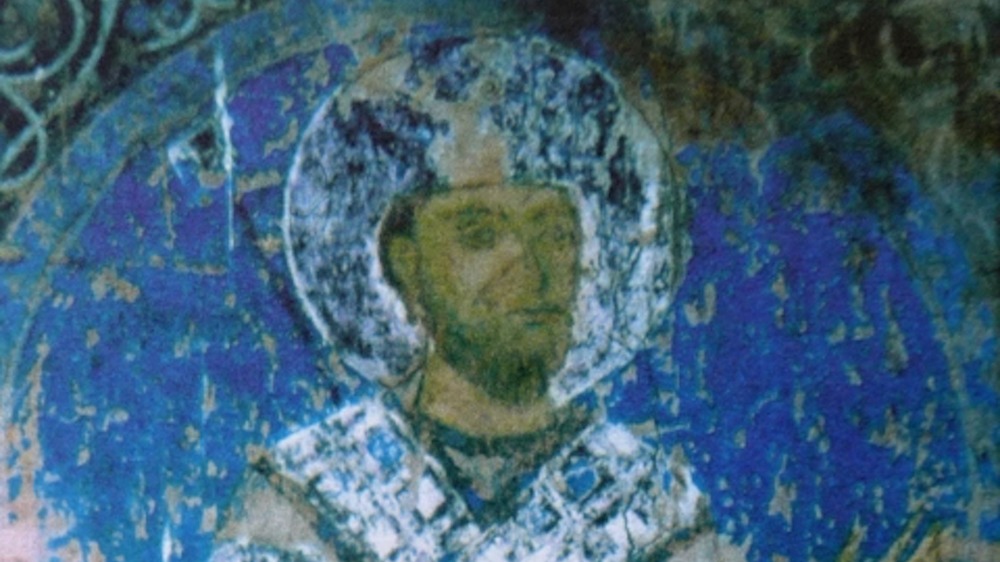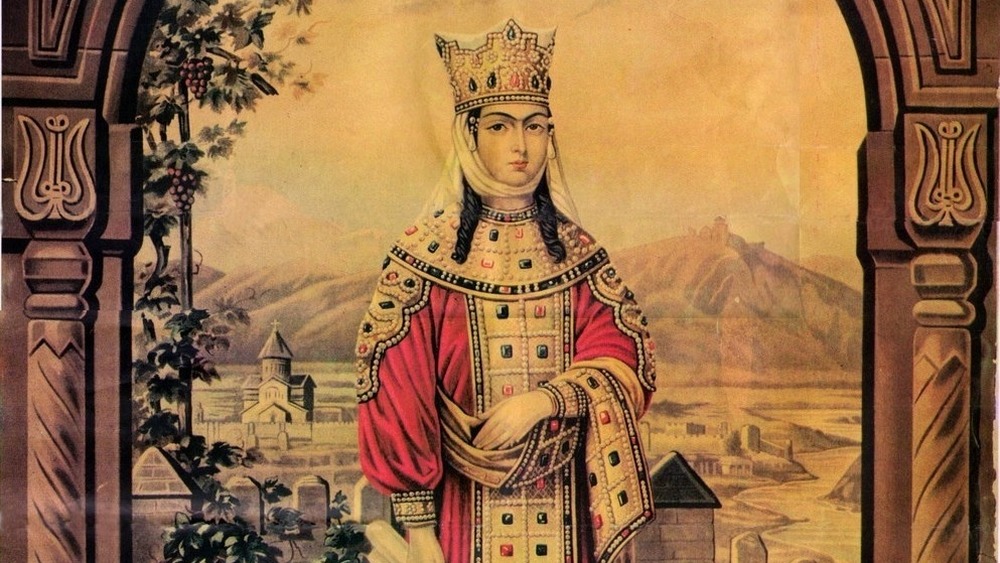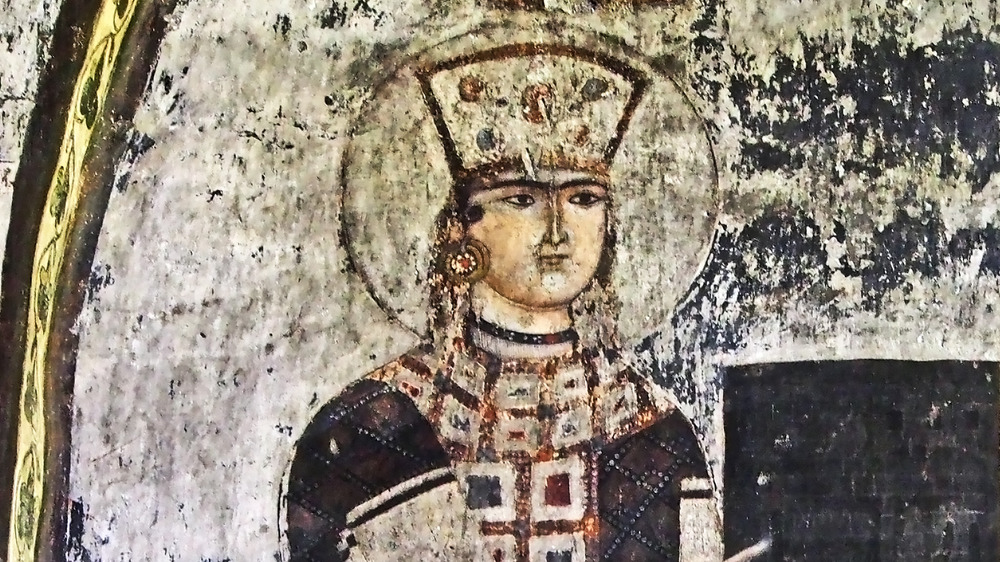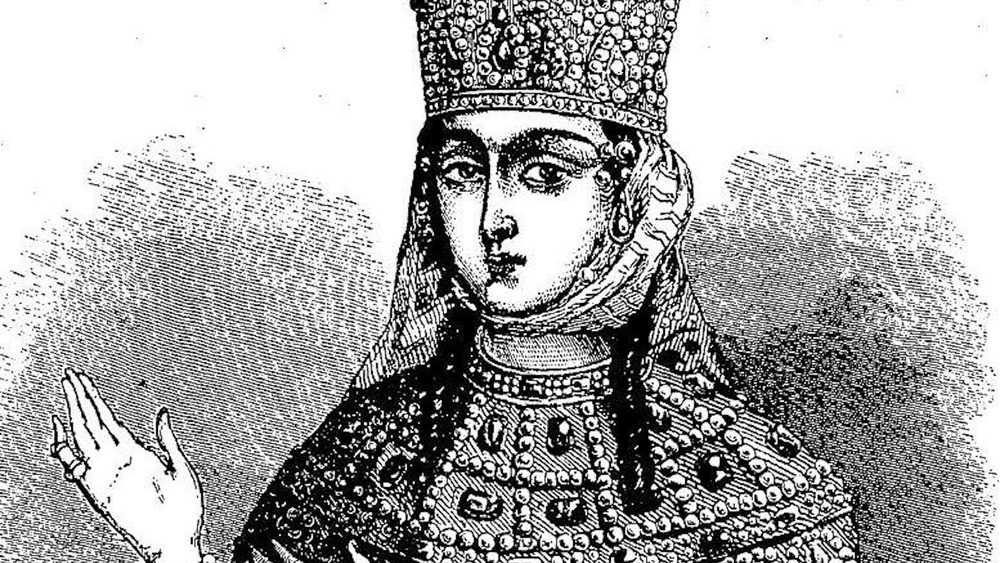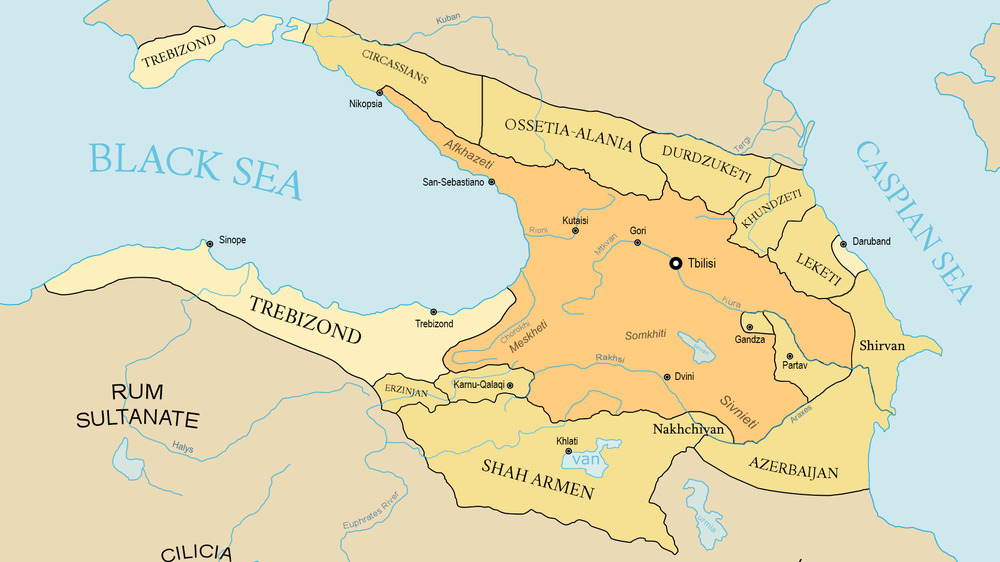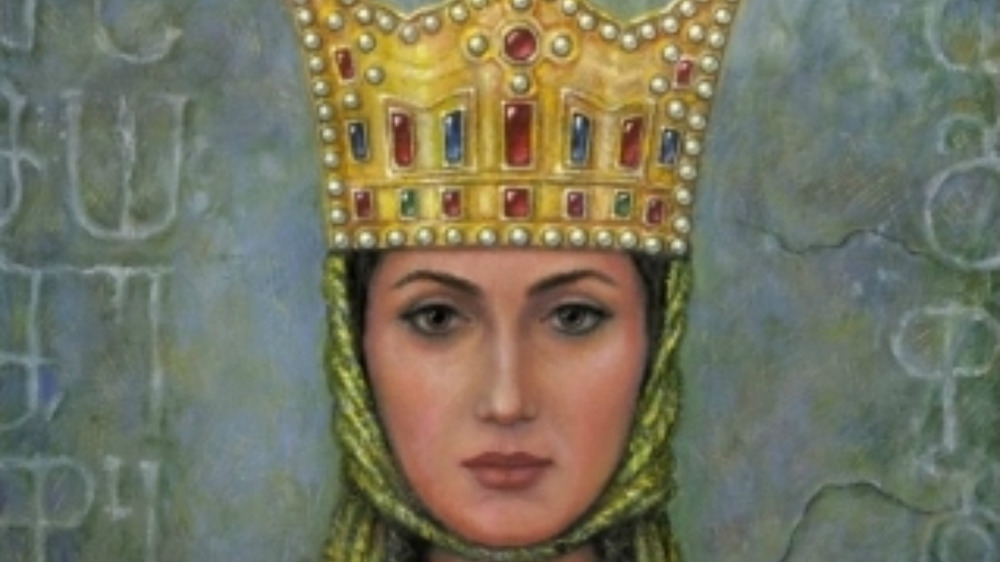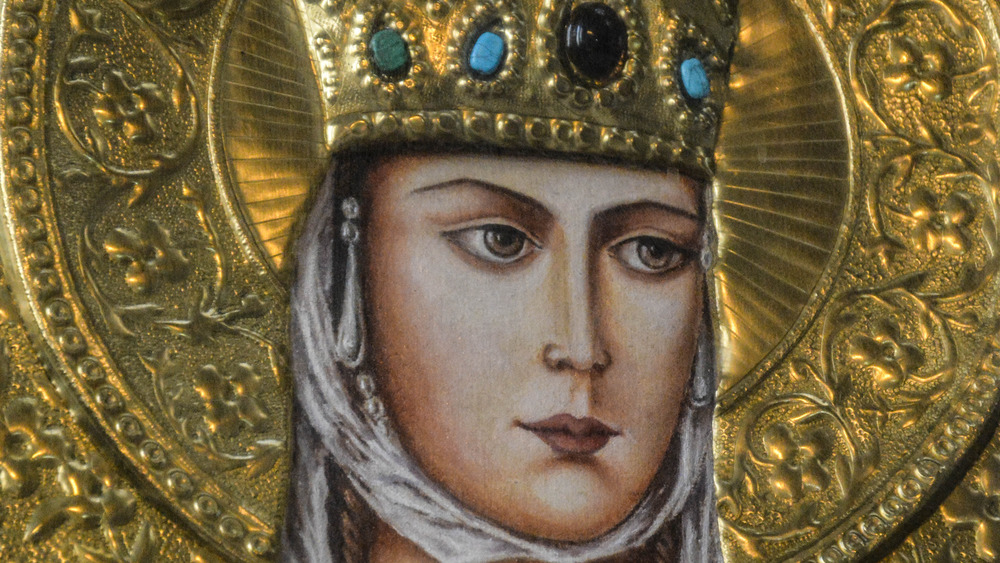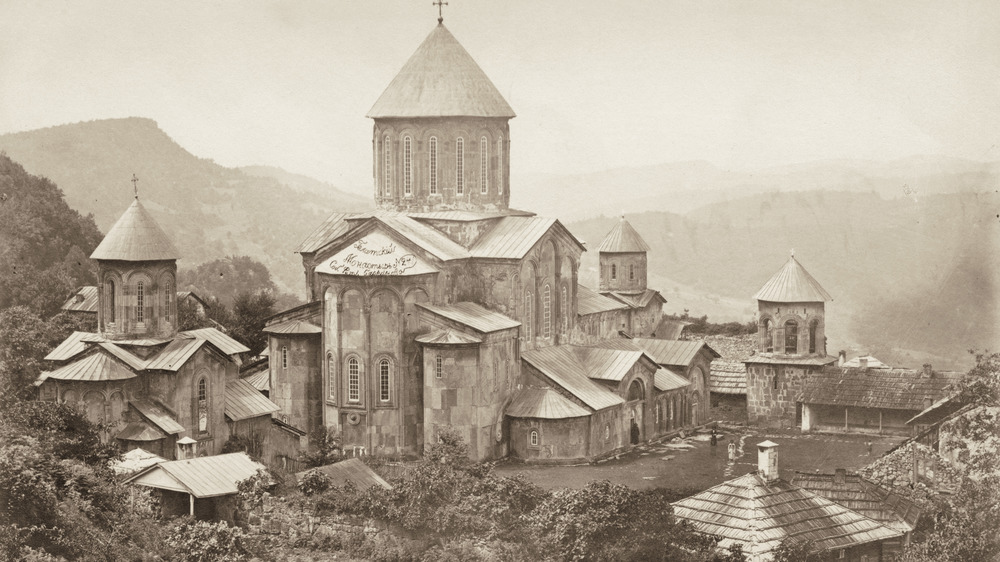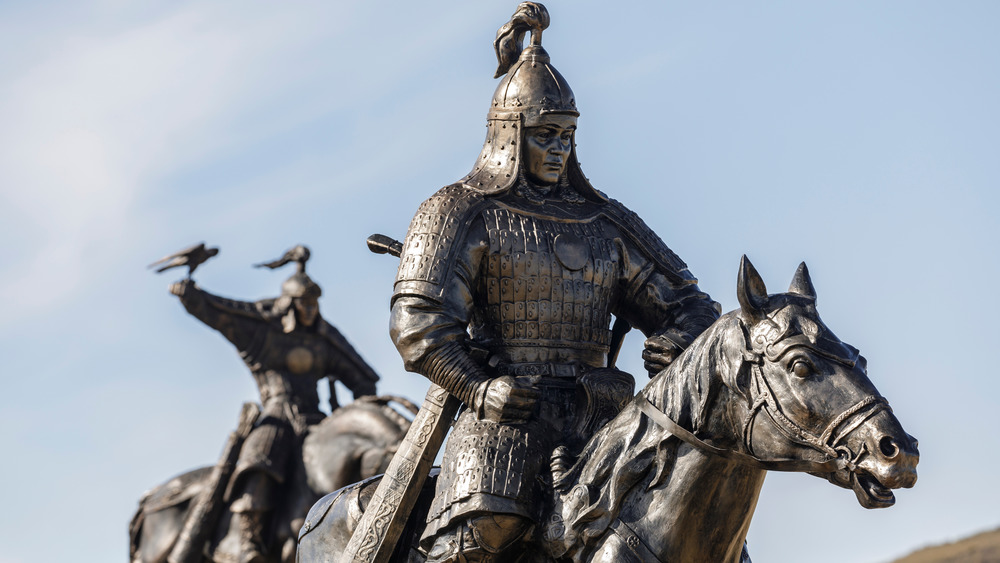The Crazy Real-Life Story Of Georgia's Only Queen
Tamar of Georgia, known as the Holy Righteous King of Georgia, is the only person in Georgia's history to have held the title of both king and queen, which is why many consider her to be Georgia's only queen. And although there are no records of her actually having fought in battle, she attained an image as a "warrior queen," as well as that of a saint. Several centuries after her death, this sainthood was made official when she was canonized by the Eastern Orthodox Church.
A fierce and pious ruler, her reign over the Kingdom of Georgia in the Middle Ages is known as the Golden Age of Georgia. Under her rule, the Kingdom of Georgia expanded its empire over the Caucasian region, while art and literature exploded.
Her reign lasted almost 30 years, and after the sack of Constantinople in 1204, King Tamar "filled the power vacuum" and became an essential power at the crossroads of East and West. Unfortunately, her son was unable to maintain Georgia's stronghold, and in 1220, Georgia fell to the Mongol Empire. This is the crazy real-life story of Georgia's only queen.
Tamar's ascent to the throne
Born in 1160, Tamar, sometimes spelled Thamar or Tamara, was the only legitimate child of George III, king of Georgia. They were part of the Bagrationi dynasty, who came to power during the sixth century and went on to reign until the early 19th century, when Georgia lost its independence.
According to The Culture Trip, in 1177, local nobles conspired to dethrone George III and replace him with his nephew Demna, whom they claimed was the rightful heir to the throne. However, King George III was able to suppress the uprising, and when Demna pleaded with King George III to spare his life, "his prayer was granted," but George III instead had Demma "blinded, castrated, and thrown into prison."
After this revolt, King George III started including Tamar in his governance, and in 1178 crowned her as "co-ruler." In doing so, King George III sought to legitimize his family's claim on the throne and discourage any controversy that might arise after his death. Although some of the nobility protested, George III declared that "One knows a lion by its claws, and Tamar by her actions."
During her coronation, Tamar was called "Mountain of God," and for the next six years Tamar and King George III shared the responsibilities of reigning. And in 1184, after her father's death, Tamar was once again crowned "to reaffirm her right to the succession" and declared the sole ruler of Georgia.
Questioning Tamar's legitimacy
Unfortunately, the coronation wasn't enough to solidify King Tamar as the rightful ruler in her opposition's eyes. In fact, the nobility had been the ones to demand that she be re-crowned. Treating her gender as a weakness, the nobles also tried to use her young age against her (via Culture Trip).
According to the Ancient History Encyclopedia, the nobles also demanded that King Tamar remove foreigners and former serfs from power, and she complied. But when the nobility demanded the power to enact laws and appoint government officials, King Tamar arrested Qutlu Arslan, the leader, and forced the rebellious nobles to back down. However, some sources say that King Tamar's ascension wasn't met with that much dissent, since the Georgian people had already had several years to get used to her rule.
But the nobles definitely exerted a degree of control over King Tamar, as is seen by the fact that they forced her to marry Rus Prince George Bogolyubsky, also known as Giorgi Rusi. The marriage was partly forced in the hopes that she would provide a legitimate successor to the throne. And while Tamar had hoped that Bogolyubsky would drum up support for her amongst the nobility as well as the military, he soon "became more of a liability than an asset."
Remaining childless and refusing to continue putting up with an unreasonable drunk who started wars with neighboring countries for no reason, in 1188, King Tamar petitioned for divorce and exiled Bogolyubsky to Constantinople.
Tamar's second marriage
After divorcing Prince George Bogolyubsky, a notably unusual act in such a Christian nation, King Tamar decided to marry someone that she actually liked. One of the reasons that the divorce was possible was because of King Tamar's relationship with the church following the death of Mikel Mirianisdze, chief bishop of the church, but it also helped that Bogolyubsky was so widely unpopular.
With the help of her aunt, King Tamar chose Ossetian Prince David Soslan, also known as Davit Soslan, as her husband, and they stayed together until his death in 1207. "The royal couple reportedly balanced each other," and their marriage produced two children, the future King Giorgi IV and Queen Rusudan. Soslan was a much more supportive husband, and King Tamar soon made him king consort.
But according to Rejected Princesses, Bogolyubsky didn't take too kindly to the divorce and exile. Ganging up with a few nobles who also opposed King Tamar and convincing the sultan of Erzurum to conquer Georgia, Bogolyubsky led two different insurrections against the queen in 1191 and 1200. But King Tamar and her new husband promptly defeated both uprisings "and in a marked departure from the policies of kings past, after his defeat, she didn't castrate Yuri [George] even a little."
While King Tamar faced several other rebellions, she always managed to maintain her power. However, being under constant threat led her to adopt more and more "aggressive military policies." But as a result, during her rule Georgia's kingdom entered into a Golden Age.
The Golden Age of Georgia
King Tamar's reign is regarded as the Golden Age of Georgia, though this description was purposefully established during her reign. There was a "conscious effort to build up the glory of the reign" during her time, writes Antony Eastmond in his book, Royal Imagery in Medieval Georgia, and the cult of personality around the queen can be considered partly responsible for this designation.
Education became more widespread during the 12th and 13th centuries, while secular writing and poetry also reached a high level of prominence during this time. According to Rejected Princesses, King Tamar personally devoted herself to the expansion of Georgian culture, pushing the country to "find its own national identity, a unique blend of east and west." This emergence of Georgian culture is also said to have contributed to the "political unification of feudal Georgia."
Shota Rustabeli's medieval epic poem, Vepkhistkaosani, or The Knight in the Panther's Skin, written in the 12th century, is said to be inspired by King Tamar's life. And according to Ancient History Encyclopedia, the poem even makes a point of noting that "the lion's whelps are equal, be they male or female."
During this time, an official collection of Georgian historical essays were also created, known as Kartlis Tskhovreba. Until the 18th century, the Kartlis Tskhovreba was periodically updated with new essays, becoming one of the main historical documents of Georgia from ancient times to the feudal age. Many important Georgian architectural monuments were also created at this time, and there were several developments in gold-work and manuscript illumination.
Georgia's territorial expansion
The kingdom of Georgia also saw its greatest expansion under the rule of King Tamar. Her kingdom extended from Erzurum, in eastern Armenia, to Ganja, in Azerbaijan, and from Bichvinta in the north to Nakhchivan in the south. And according to Ancient History Encyclopedia, after Constantinople was sacked in 1204, King Tamar expanded her reign into "Byzantine territory on the Black Sea."
And without imposing dictatorial means, King Tamar increased her power not only over the Georgian kingdom but amassed authority over the neighboring lands as well. But her expansion of the kingdom of Georgia wasn't always met kindly. On Easter in 1209, the sultan of Ardabil in Azerbaijan led an attack on the Ani, the former capital of Armenia, storming churches and massacring over 12,000 Armenians in retaliation for Georgia's expansion into Ardabil and Tabriz in 1208. Armenians had welcomed the rule of Georgians over that of the Seljuk Turks and were able to hold prominent positions among the Georgian nobility.
But in 1210, the kingdom of Georgia advanced as far as Khoy and Qazvin, establishing an empire that spanned from the Caucus Mountains to Lake Van and from the Caspian Sea to the Black.
King Tamar was fiercely respected
Contemporary rulers fiercely admired and respected King Tamar. According to Overlando, Ivan the Terrible of Russia called her "the most wise Queen of Iberia, endowed with the intelligence and courage of a man." And Saladin, sultan of Egypt and Syria, who conquered Jerusalem in 1187, honored King Tamar's request to return the objects and relics that had been in Georgian monasteries in the city.
While most Georgian queens ruled as regent, King Tamar was considered both a king and queen in her own rights. With this, her title was exceptionally grand – "By the grace of God, King of Kings, Queen of the Queens of the Abhakazians, Armenians, Kakhetians and Kartalians, Autocrat of all of the East and the West, Glory of the World and of the Faith, Champion of the Lord."
It is for this reason that King Tamar is known as Georgia's "only queen." According to Royal Imagery in Medieval Georgia, the title "mepeta mep'e" ("king of kings") would typically be translated as "sovereign of sovereigns," since the Georgian language doesn't have grammatical genders. However, the word "dedop'ali" ("queen") also existed and was typically used for consorts who were women. So "although mepe may not be a specifically masculine word, its feminine equivalent gives it such associations." Although King Tamar is also referred to as dedop'ali in some writings, the fact that she was described by both titles "marked out her unique position among women."
Fighting against the Seljuk
Not everyone treated King Tamar with the respect she deserved. Under the leadership of Seljuk Rûm Sultan Rukn al-Din Suleymanshah II, Georgia's Muslim neighbors unified against King Tamar around 1202. And Sultan Rukn wasn't afraid to let King Tamar know what he thought of her. According to Tamta's World, by Antony Eastmond, his letter even opened with the line, "Every woman is feeble of mind." The letter also informed King Tamar that if she converted to Islam then she could marry the sultan, but if she chose to remain Christian then she would be made a concubine.
Such offense was taken at the rudeness of the letter that "one of Tamar's courtier's hit Rukn's courier hard enough that the courier passed out." When the messenger regained consciousness, King Tamar informed him that she had no intention to marry the sultan and that she'd rather defeat him.
According to Overlando, after receiving the letter, King Tamar went to the cave fortress of Vardzia and addressed her troops while barefoot, boosting their morale towards victory. Afterwards, her husband promptly led the troops to defeat the sultan in the Battle of Basiani in 1203 or 1204. In doing so, Georgia was able to strengthen not only its southern borders but its overall position in the region as well.
Tamar named a saint in her lifetime
King Tamar was known for her piety, stories of which include claims of fasting, sleeping on a stone bed, and distributing her handmade "embroidery to the poor." She even claimed to have experienced visions at times. And according to Juicy Ecumenism, in addition to endowing multiple monasteries and cathedrals, both in Georgia and the Holy Land, King Tamar also "provided protection for Christian pilgrims traveling between the holy sites."
When King Tamar was rallying her troops before the Battle of Basiani, she prayed with them for an extended period of time. Afterwards, she ordered all the nobles to "approach the Holy Cross, do obeisance, and kiss it." As the troops rode off into battle, King Tamar made the sign of the cross, giving her blessing, "and so they rode away trusting in God and in the tears of Tamar."
Centuries after her death, King Tamar was canonized as the Holy Righteous King Tamar by the Eastern Orthodox Church, with a feast day on May 14, but her tie to Christianity had been well established during her rule, to the point where she was named a saint during her lifetime in the Vani Gospels.
The death of Tamar
Near the end of her life, King Tamar was struck by a mysterious illness, though for a long time she kept it secret. Finally, when the pain was too great she reached out to doctors for help, but none were able to diagnose her illness. Thousands "prayed fervently for Georgia's ruler and defender," but on Jan. 18, 1212, King Tamar passed away. Her death had been so unwanted by her subjects that "medieval chronicles indicate that some of her subjects offered to die in her place." According to Itinari, some believed that her body would be disrespected if it fell into enemy hands, so her burial was kept a secret. "Nobody ever saw her remains," and it's still unclear where she was buried.
One legend claims that she's buried in a small cathedral in Svaneti. In another version, 12 coffins were buried at the same time to keep the true location secret. However, it's widely believed that after being held at Svetitskhoveli cathedral, King Tamar's body was moved to a tomb in Gelati.
But when Ekvtime Takaishvili started an archeological excavation to find the grave in 1919, they found an inscription that read, "Whoever touches this grave and dig or express disrespect, will be cursed forever." Workers refused to continue their work, and no one has ever tried to dig up the grave since. As a result, no one knows exactly where King Tamar was buried, though it's assumed that she rests in Gelati.
The fall of Georgia
After King Tamar's death, her son George IV Lasha, also known as Giorgi IV, took over, and it was believed that he could continue Georgia's golden age. But according to Ancient History Encyclopedia, George IV exhibited too much impulsiveness, and soon Georgia was losing influence over its vassal states. In 1220, a rival empire forced Georgia under its yoke.
According to Georgia, by Michael Spilling and Winnie Wong, the Mongol invasion was the final nail in the coffin for Georgia's golden age. King George IV was killed in battle against the Mongols, and for 100 years the Mongol empire dominated Georgia, "taxing the Georgians heavily."
In 1259 King David Narin established a separate kingdom in western Georgia, while Samtskhe became "an autonomous principate under Mongol control in 1266." After several failed coups against the Mongols, they were finally driven out of Georgia in the early 14th century, although they retaliated with several invasions later in the century.
The Lion of Georgia
Despite the fall of Georgia to the Mongol Empire, King Tamar created a lasting legacy. Known as the "Lion of Georgia," especially due to Shota Rustabeli's epic poem about her, King Tamar was instrumental towards the expansion of Georgian culture as well as Christian culture. An inspiring ruler, she was known for her piety, her mercy, and "her genuine love for the poorest of her people." It's even said that during her rule, she abolished the death penalty and all forms of bodily torture, a stark departure from her father's method of governance.
King Tamar and her kingdom also played a substantial role in Christianity's survival in the Middle East. As she repeatedly resisted invasions by Muslim armies, allowing Christianity to flourish in both Georgia and Armenia, she also set a precedent for "Georgian monarchs after her to serve as the protectors of Christian pilgrims en route to the Holy Land."
According to Rejected Princesses, in the 21st century, Tamar remains one of the most popular names in Georgia. Her portrait is printed on the 50 lari note, and there's even an airport named after her.
